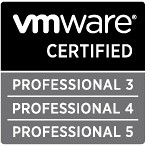What is VMDirectPath I/O
VMDirectPath I/O is a VMware technology that can be used with I/O hardware to reduce the CPU impact of high-bandwidth throughput workload's by ‘‘bypassing’’ the hypervisor. It is supported for specific networking adapters in vSphere ESX 4, and it is experimental for specific storage adapters in vSphere ESX 4.
By allowing virtual machines to directly access the underlying hardware devices, VMDirectPath I/O device access enhances CPU efficiency in handling workload's that require constant and frequent access to I/O devices. VMDirectPath I/O for networking I/O devices is fully supported with the Intel 82598 10 Gigabit Ethernet Controller and Broadcom 57710 and 57711 10 Gigabit Ethernet Controller.
Prerequisites
1. To use VMDirectPath, verify that the host has Intel® Virtualization Technology for Directed I/O (VT-d) or AMD I/O Virtualization Technology (IOMMU) enabled in the BIOS. Refer to my earlier post.
2. Verify that the PCI devices are connected to the host and marked as available for passthrough.
3. Verify that the virtual machine is using hardware version 7.
Drawbacks
Use of the VMDirectPath disables many advanced VMware functions for the virtual machine, so be careful before you start using VMDirect Path.
1. VMotion
2. High availability
3. Suspend and resume
4. Record and replay
5. Fault tolerance
6. Memory overcommitment and page sharing
7. Hot add/remove of virtual devices
8. No Snapshot backup
Few Good links about VMDirect Path I/O
1. A video is posted here by chad which will show you step by step instructions. All though this link is for Cisco Unified Computing (UCS) but still it will help – Link
2. VMware VMDirect Path I/O by Simon Long
3. To check for device compatibility please visit here
4. Configure VMDirect Path article 1010789
5. Troubleshooting VMDirect Path
6. http://communities.vmware.com/docs/DOC-11089
7. Scott Lowe blog about VMDirect Path


Leave a Reply